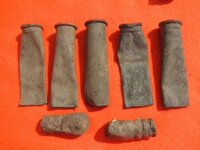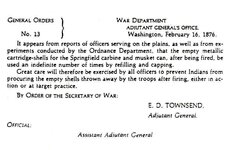Montana Jim
Gold Member
Many of you know that my partner Wingman Tony and I have dug hundreds of western Indian War era .45-70 and .50-70 military fired shell casings. Almost all the shells are crushed to a certain degree.
We used to think that they were crushed by subsequent cattle stomping or maybe, as in the case of crushed and folded shells, the work of plow blades for the last 130ish years. It never dawned on us that the soldiers may have stomped the used shells...
Here is a picture representing what we usually find.

Research brought us the below tidbit... it may actually have been the soldiers!
Read this General Order from the Adjutant General dated February 16, 1876.

All our relics are from training or camping areas, and not from known battle sites... so I don't know what to think. I also find it hard to believe that in battle soldiers would actually stop and stomp a shell so Indians couldn't recover and use it!
What do you think?
We used to think that they were crushed by subsequent cattle stomping or maybe, as in the case of crushed and folded shells, the work of plow blades for the last 130ish years. It never dawned on us that the soldiers may have stomped the used shells...
Here is a picture representing what we usually find.

Research brought us the below tidbit... it may actually have been the soldiers!
Read this General Order from the Adjutant General dated February 16, 1876.

All our relics are from training or camping areas, and not from known battle sites... so I don't know what to think. I also find it hard to believe that in battle soldiers would actually stop and stomp a shell so Indians couldn't recover and use it!
What do you think?








